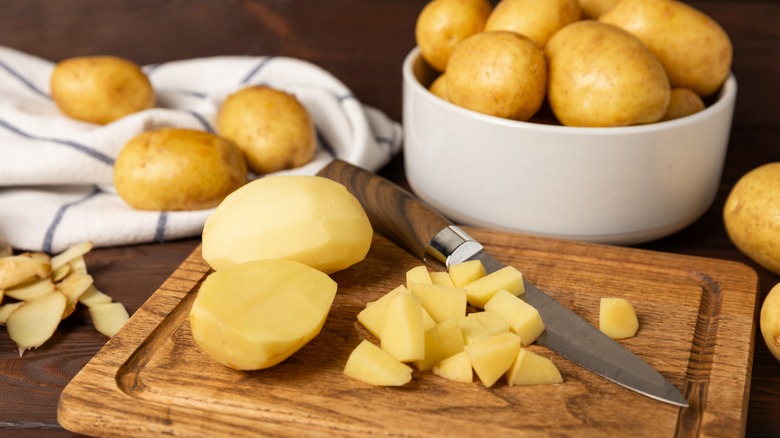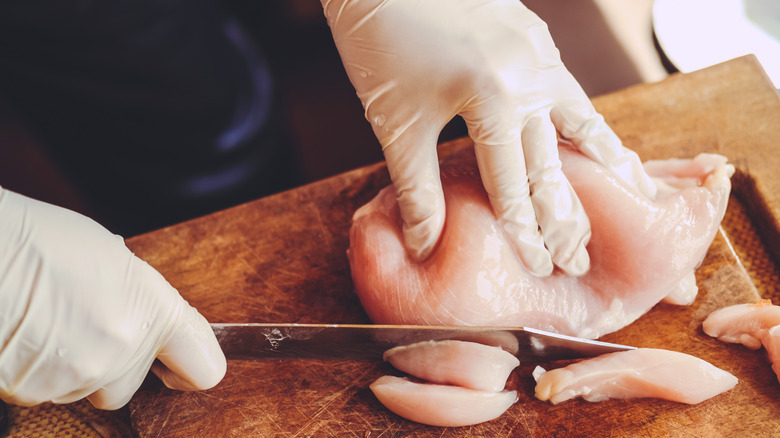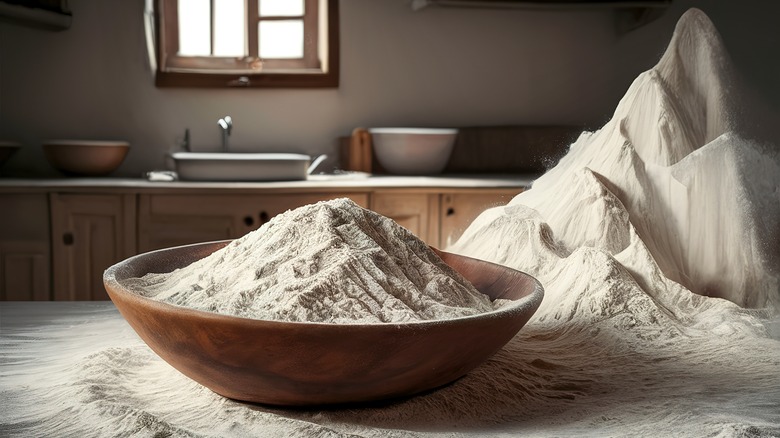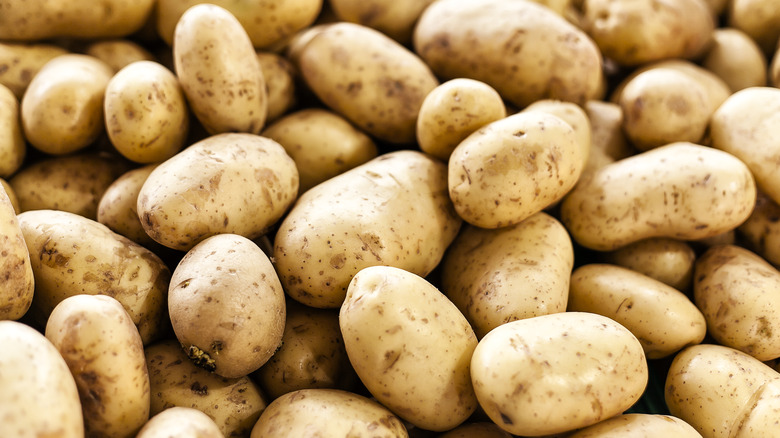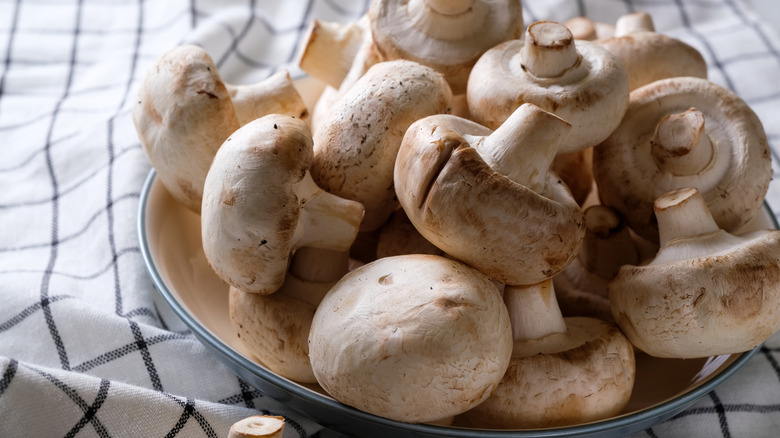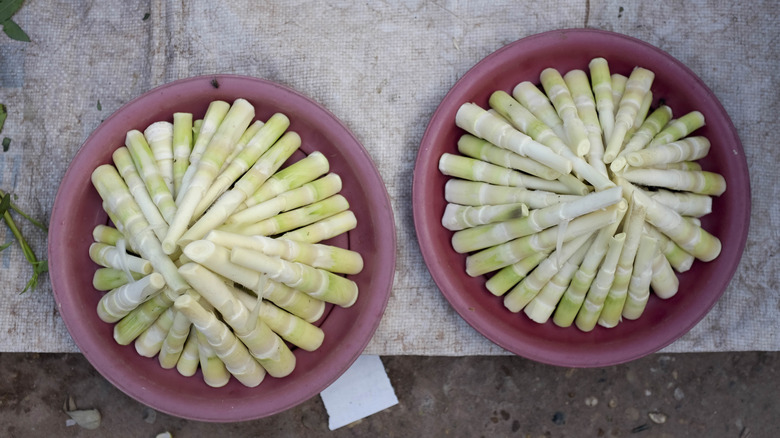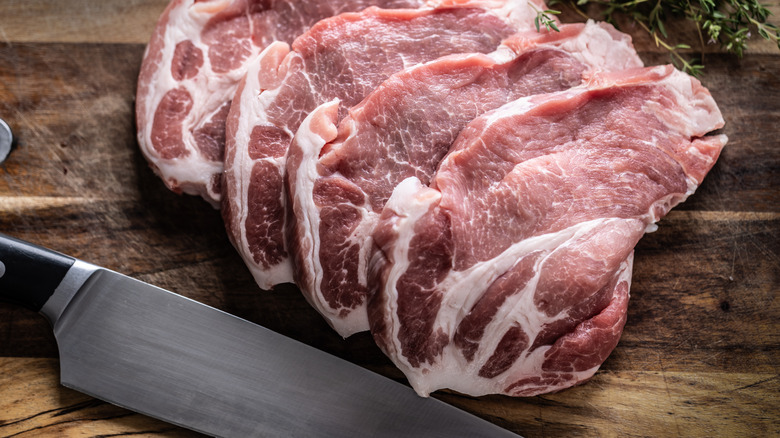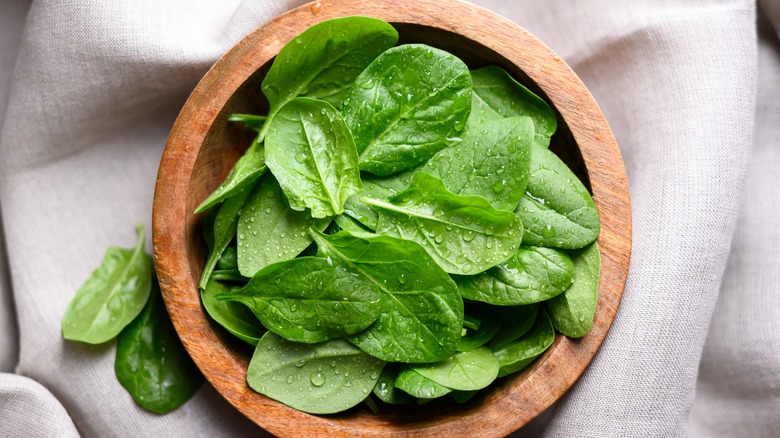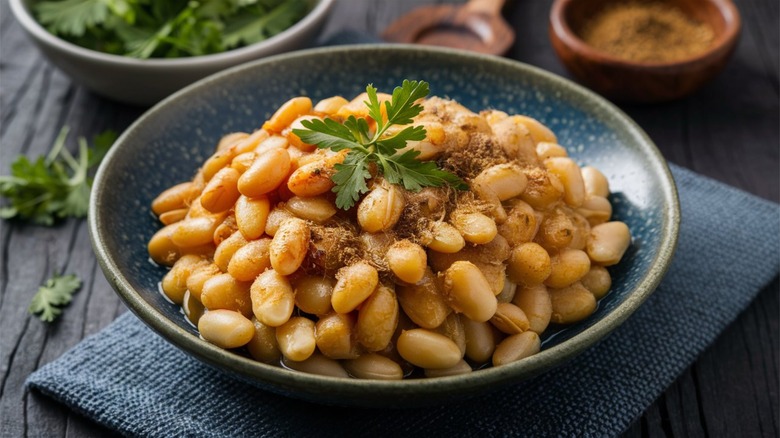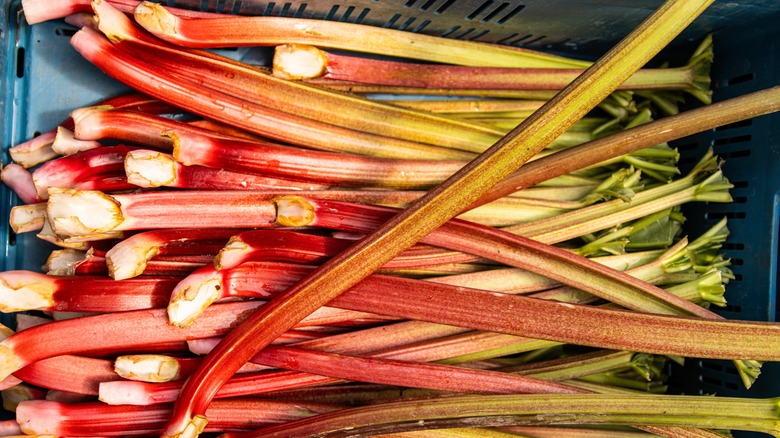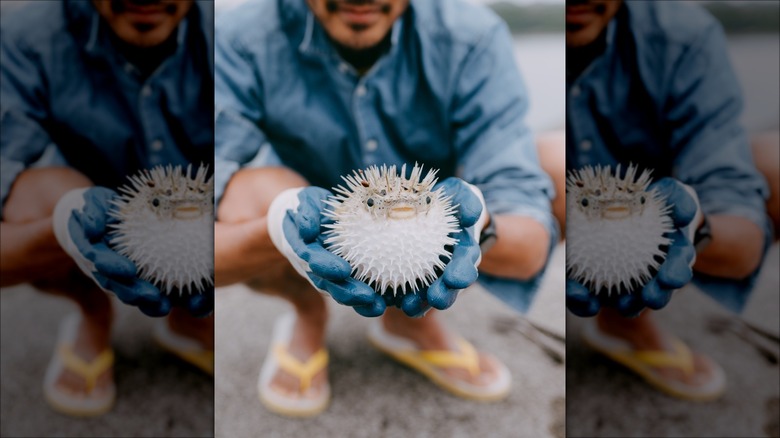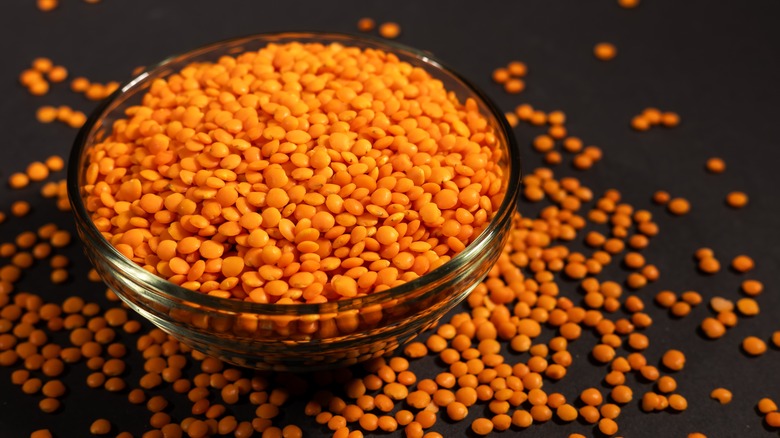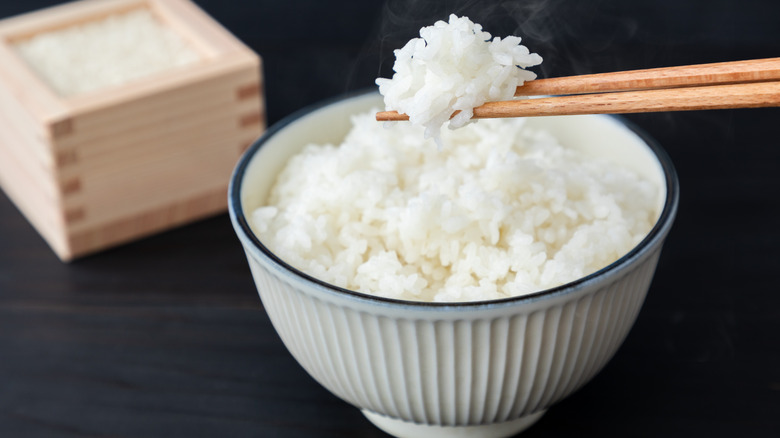Foods That Can Be Toxic If You Cook Them Incorrectly
We may receive a commission on purchases made from links.
Good cooking is a science and, just like in the lab, the wrong move at the wrong time can sometimes have disastrous consequences. While the consequences of most blunders are more "disastrous" in the melodramatic sense — think burnt edges, unpleasant flavors, or haphazard presentation — in some rare circumstances they can actually take a serious toll on your health.
The reality is that a lot of the foods we consume on a daily basis harbor some little known secrets. Certain ingredients have the potential to become toxic if cooked wrong — whether that's by overcooking, undercooking, or just disregarding the cooking steps completely. While we all know that dining out runs the slight risk of contracting food poisoning, a lot of us underestimate the risk of doing so in the comfort of our own homes when we mishandle our food.
Cynical as it sounds, there's nothing you can do to totally eliminate that risk. Here's a guide to the foods that pose the greatest risk of making you sick if cooked incorrectly — you may want to be extra careful next time you whip up a dish with one of these 12 foods.
Chicken
We'll start with one you probably already know. Raw chicken is notoriously prone to harmful bacteria, such as campylobacter, E. coli, salmonella. The latter has a particularly infamous connection with chicken. As per the Centers for Disease Control and Prevention (CDC), roughly one in every 25 packages of chicken at your local grocery store is probably contaminated with salmonella, which can cause some pretty unpleasant symptoms such as vomiting, diarrhea, and fever in as little as a matter of hours. These are usually typically mild (even if they don't feel like it at the time), but a small percentage of people can end up hospitalized.
That's why it's so important to thoroughly cook your chicken. You've heard this all before — understood. But it can't be stressed enough how quick and easy it is to kill any potential bacteria lurking inside raw poultry. While the exact length of time it takes to cook your chicken will differ depending on the size and thickness of the cut, as a general rule, chicken that's cooked to an internal temperature of 165 F is good to go. A meat thermometer will be your best friend here — just be sure to thoroughly clean it after every use. Also, don't be tempted to wash your chicken pre-cooking. Not only is there no scientific need, but according to a USDA study, one in seven people had germs left in their ink post-clean, which could just as easily infect other items or foods.
Flour
We've all heard (and potentially ignored) the warning about eating raw cookie dough. As it turns out, this advice isn't totally about being a buzzkill — or about the potential risk posed by consuming raw eggs. Instead, it's about the dangers posed by consuming uncooked flour. Grain can easily be contaminated while it's still in the fields, and as flour typically isn't treated for germs during production – and germs won't be killed by the grinding or bleaching process — that means that the flour you pour into your doughs, cake mixes, and other baked goods is very much still raw.
The worst case scenario for consuming uncooked flour has played out on a nationwide scale multiple times in the past. In 2023, for example, we saw a wave of salmonella hit the United States that was linked to customers eating raw Papa Murphy's cookie dough. That same year, three people were hospitalized after contracting salmonella from Gold Medal all-purpose flour. Three more people were hospitalized for a similar outbreak in multiple brands of flour in 2019. Consuming uncooked flour is a no-go, no matter how tempting that cookie dough may look. (Besides, that's why they invented ready-to-eat cookie dough). So, make sure to thoroughly cook any product that contains flour.
Potatoes
Back in the fall of 1979, 78 boys suddenly fell ill at a school in London. What followed was mass vomiting, diarrhea, pain, and fever — until, five days later, everything stopped. As it turned out, the culprit was a bag of potatoes that had been left in storage since the summer then boiled and served to the boys as part of their daily meal. These potatoes had an alarmingly high concentration of solanine, aka a glycoalkaloid poison that's also found in the infamous deadly nightshade.
This is obviously a pretty extreme situation, but it goes to prove just what spuds are a capable of when improperly prepared. Versatile and delicious, potatoes always contain glycoalkaloids. You'll need to consume a relatively high dose to feel ill à la London 1979, and raw potatoes are safe to eat in low doses, but to keep that risk as low as possible, it's recommend that boiling, baking, or microwaving your potatoes will bring down the glycoalkaloids. The high temperatures of the cooking process also destroy the potato's lectins – a kind of protein that binds to carbohydrates and can cause symptoms such as nausea, vomiting, and diarrhea if consumed in large quantities.
Mushrooms
Mushrooms are high in antioxidants, low in sodium, and boast a whole wealth of health benefits. They also have a strong cell wall made of a carbohydrate called chitin, which cooking can make easier for the body to digest. Not only that, but they can come bearing potential parasites, bacteria, or viruses that are killed during the cooking process, saving you from potential food poisoning like the bout that left 51 people ill and two dead after dining at Dave's Sushi in Montana in early 2024.
Of course, any food can be contaminated with bacteria. What makes mushrooms unique is the presence of agaritine in some species. This is a chemical compound that's raised some concerns about possibly being carcinogenic. Some fear that eating mushrooms raw could increase your risk of cancer, with a Food and Chemical Toxicology study finding that 4 grams of Swiss mushrooms a day may cause "a lifetime cumulative cancer risk of about two cases per 100,000 lives" and another study by the National Library of Medicine concluding that mushrooms were less carcinogenic after being cooked. The research here is still ongoing, but there's nothing wrong with cooking your mushrooms anyway, just to be safe.
Bamboo shoots
Pandas may routinely chow down on raw bamboo shoots, but that doesn't mean you should. While they're packed with nutritious vitamins and minerals such as vitamin B6, potassium and copper, they're also typically full of chemicals known as cyanogenic glycosides which can release hydrogen cyanide while you chew. Yep, as in the poison cyanide, which pandas have the ability to convert then pee out. The more you know, right?
While we sadly don't share that skill, bamboo shoots don't have to come with a side of poison. To properly prepare your bamboo shoots, you need to remove their exteriors, boil them for between 20 minutes and two hours (or at least until the shoots are soft), then dry. It's only then that they're safe to eat. If you purchased your bamboo shoots in a can (which is the most common way to buy them in the United States), then you're good to toss them straight into your stir-fry, soup, curry, or the dish of your choice — no boiling or drying required.
Pork
All meats can be infected by bacteria or parasites, but pork is often flagged as one of the most frequent victims. While some cultures eat raw pork, the general consensus in the United States is that it's simply not worth the risk due to its proclivity for parasites such as trichinella spiralis — a roundworm that can infect you with trichinosis, aka trichinellosis. We won't go into too many details (for the sake of your stomach) but let's just say that once trichinella larvae start growing into larvae, things aren't pretty.
You also run the risk of contracting taenia solium or taenia asiatica, both of which are tapeworms that can respectively lead to taeniasis or cysticercosis infections. Your best way to eliminate these threats is — you guessed it — cooking your pork. As per the USDA, the ideal internal temperature for your meat should be 145 F. Again, this is where a meat thermometer would come in extra handy.
Spinach
Spinach is a bonafide nutritional powerhouse, packing massive amounts of vitamins A, C, and K, plus antioxidants, fiber, and magnesium into every tiny green leaf. However, all of this is rendered somewhat irrelevant if you fail to reheat your spinach properly and instead flood your body with nitrosamines.
In layman's terms, nitrosamines are a potentially harmful compound made out of nitrates, which are good for your body in moderation. But if you don't reheat your spinach the right way — by which we mean cooking it for too long or at too high a heat — you can accidentally release even more nitrates. A study by the University of Medical Sciences in Iran found that cooking led to a significant increase in nitrate levels in spinach, while another study by Foods found that if you stir-fried spinach, you increased the nitrate concentration by 31%. The high temperatures can then turn all this bonus nitrate to nitrosamines, which are considered carcinogenic.
Lima beans
Lima beans go by many names, such as "Madagascar beans," "Rangoon beans," and "butter beans." Whatever you call them, they're delicious, with a nutty yet creamy flavor that's not too far away from the likes of edamame beans.
Raw lima beans are actually toxic, containing a cyanogenic glucoside known as linamarin that breaks down into hydrogen cyanide when chewed, crushed, or stirred. Lima beans you find in the wild contain much more cyanide than those sold in the United States, where the cyanide content is typically between 100 and 170 milligrams per kilogram and the maximum is less than 200 milligrams.
Again, just like the bamboo shoots, it's relatively easy to de-poison your beans if you follow the right steps. The best way is to boil them — ideally for longer than 30 minutes, as this will neutralize roughly 80% of the cyanide — but you can also leave them to soak for up to 48 hours, then boil them for five minutes. This will destroy the enzymes that help release the cyanide. Simple yet effective (and, most importantly, not poisonous).
Rhubarb
Rhubarb has played a key role in traditional Chinese medicine for thousands of years, easing everything from chronic constipation to inflammation. The Romans used it for bowel-cleansing, while Benjamin Franklin introduced it to a friend who was working as a botanist for the King of England in its American colonies. Some people even think it can help relieve cold sores and lower your cholesterol. Point being: This is a handy plant. But not all of the plant is quite as beneficial.
In fact, cooking and consuming some parts of rhubarb could prove dangerous. The thing is that rhubarb contains oxalate, a compound that negatively affects how your body absorbs calcium and minerals. The most oxalate can be found in the leaves, which is why it's imperative that you cut them off before you start cooking or preparing your rhubarb stalk (which contains next to no oxalate).
While rhubarb stalks also contain oxalate, it's considerably less than the leaves. It would take a fair amount of rhubarb leaves, never mind the stalks, to actually make you sick, but it's not totally unheard of for oxalic acid to build up and contribute to serious kidney problems. Slightly less serious but still concerning symptoms include brief vomiting and diarrhea, as well as nausea and abdominal pain.
Fugu
To say that fugu, also known as puffer fish and blow fish, is a difficult dish to master is an understatement. In Japan, chefs need to pass an exam before they're qualified to get started (although this test became a lot easier in 2012, with a 10-year-old chef since becoming an accredited fugu expert). The reason behind this is that these scary-looking fish contain a neurotoxin named tetrodotoxin which is 1,200 times stronger than cyanide and, if consumed, can cause paralysis, asphyxiation, and even death.
Theoretically, you should only ever be served fugu by a trained professional who fully comprehends the complex steps of delicately removing the toxic parts of the fish without accidentally releasing the toxins into the rest of its flesh. It's typically served sashimi style, but some chefs (mostly the inexperienced ones) experiment with other parts of the body. Back in 2009, seven people were hospitalized in Japan's Tsuruoka city after trying grilled puffer fish testicles, a feat that's illegal in Tokyo and Osaka. This is definitely not something you should ever try yourself, with those who've attempted something similarly haphazard with fugu meeting equally tragic fates (50% were poisoned by the liver, 7% the skin, and 43% had been poisoned by the ovaries).
Lentils
As is the case with most of the foods on this list, undercooking is the risk you face with lentils. While they're relatively straightforward to make (toss them into a pan of water, cover and boil for up to 20 minutes), not leaving them to cook for long enough can lead to trouble with a specific type of protein called lectins, which are sometimes given the totally non-comforting nickname of "anti-nutrients."
Lentils, like a lot of legumes, are pretty heavy in lectins while raw. This binds to carbohydrates in your body, which means you can't digest them and you're left with either bloating, vomiting, diarrhea, or all of the above. This is why so many people recommend soaking your lentils before cooking, as the process can neutralize lectins. However, due to their size, lentils only require a brief soak before hitting the pan, which is where the heat will break down the lectins to make them even more digestible. You'll need to follow a similar process for any beans, as lectin is, unfortunately, a common issue in the legume family. The silver lining here is that lentils take considerably less time to push through the lectins compared to its brother and sister legumes.
Rice
Some people have their qualms about reheating rice, with "reheated rice syndrome" seemingly going viral on social media every now and then to give us another dose of dread. The reality is that, yes, a bacteria called bacillus cereus has been known to grow on rice, and no, zapping it in the microwave can't kill it as it grows well in hot temperatures. Go figure. However, you can minimize that risk by not leaving your rice out at room temperature for more than two hours, and keeping it refrigerated until it's time to reheat.
Whether you're reheating or initially making your rice, you should also be careful not to overcook. Cooking your rice at too hot a temperature for too long can lead to the accumulation of acrylamide, a known carcinogen with potential links to risks of cancers of the mouth, bowel, breast and ovaries. However, the emphasis here is on "potential." While we know that overcooking rice (and, in fact, overcooking other foods, too) produces acrylamide, and acrylamide was linked to cancer in some animal studies using much more of the former (albeit in much bigger quantities than we'd ever consume in one go), this remains more of a cautionary warning than a hard-and-fast rule until any definite link is made between the two.
